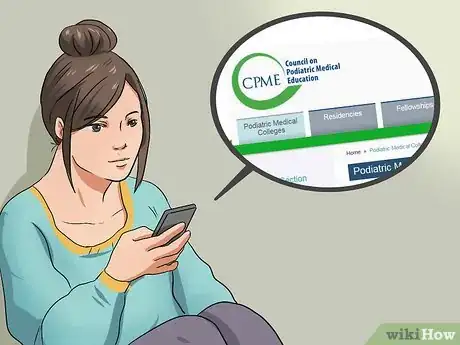wikiHow is a “wiki,” similar to Wikipedia, which means that many of our articles are co-written by multiple authors. To create this article, 12 people, some anonymous, worked to edit and improve it over time.
There are 14 references cited in this article, which can be found at the bottom of the page.
This article has been viewed 24,284 times.
Learn more...
A podiatrist is a doctor who specializes in the treatment of the feet, ankles, and lower legs.[1] To become a podiatrist you must complete at least seven years of postgraduate education before you are licensed and able to work independently with your own with patients. Like all other doctors, podiatrists spend a lot of time and energy, not to mention money, to become good at what they do.
Steps
Completing an Undergraduate Degree and the MCAT Exam
-
1Take advanced placement classes before college. Prepare yourself for the rigors of years of medical training by taking advanced placement classes during high school. While these type of classes are not available at all high schools, and are not a requirement of getting a Pre-Med degree, they will put you on good footing when starting college.
- It's important to develop a work ethic early. Advanced placement classes will help you get a foundation understanding of complex topics but they will also help you become used to the extended periods of study you will need to complete during your medical education.
- AP credits in high school may even count as college credits in some cases. Remember, however, that those same credits, while they may help you get your undergraduate degree, may not count toward the prerequisites required to get into medical school.[2]
-
2Complete a bachelor's degree in premed. A premed degree will include most, if not all, of the required prerequisites to get into medical school. Classes taken should include a wide variety of topics in the sciences, especially biology, in addition to classes in English, Math, and other general requirements.
- If you choose not to major in premed you can still go to medical school. It just means that you will have to complete required classes for medical school, in addition to those required for your major.[3]
- Prerequisites for podiatric college include at least 8 credit hours each of Biology, general or Inorganic Chemistry, Organic Chemistry, Physics, and English. All of the Science classes also need to include a lab.[4] Make sure that your undergraduate education includes all of these prerequisites.
Advertisement -
3Pass the Medical College Admission Test, also known as the MCAT. Even more than what undergraduate degree you get, medical schools are looking at MCAT scores to judge whether you should be admitted.[5] The MCAT is designed to test "problem solving, critical thinking, and knowledge of natural, behavioral, and social science concepts and principles."[6]
- The MCAT consists of four multiple-choice sections. The first section is "Biological and Biochemical Foundations of Living Systems," the second section is "Chemical and Physical Foundations of Biological Systems," the third section is "Psychological, Social, and Biological Foundations of Behavior," and the fourth section is "Critical Analysis and Reasoning Skills."[7] The full test is 230 questions and takes a little over four hours to complete.
- Studying for the MCAT is an important step toward passing the exam. You can either buy published study guides or use online study guides and practice tests. Either way, you need to devote a lot of your time to studying leading up the the test.
Completing Podiatric College
-
1Find a college of podiatric medicine.[8] There are 9 accredited colleges of podiatric medicine in the US.[9] These colleges have all been accredited by the Council on Podiatric Medical Education.[10]
- While you may have to move to go to a podiatric college, because of their limited number, these schools will give you the specialized education and experience that you will need to become a successful podiatrist.
-
2Apply to podiatric college. This can be done on the website of the American Association of Colleges of Podiatric Medicine.[11] With one application on their website you can apply to all nine colleges of podiatric medicine at the same time.
- Applicants to podiatry school with be evaluated on their GPA, MCAT scores, and an interview, in addition to a variety of extracurricular activities. Experiences in the medical field, such as volunteer work or shadowing a podiatrist are good to have as extracurricular activities, although the requirements for admission can vary from school to school.[12]
-
3Complete the requirements for your Doctor of Podiatric Medicine (DPM) degree. These requirements will vary slightly from school to school but all will be very similar to any medical schooling, aside from the focus on the foot. Topics will include anatomy, physiology, and pharmacology, among others. In addition, students will need to learn about medical ethics and regulations about the practice of podiatry.
- Podiatric medical school will also include hands on training. Students will need to complete several clinical rotations before graduating. These rotations are usually completed during the last two years of the program.[13]
-
4Pass the first two parts of the National Board exams. They are taken in two parts while in podiatric medical school.[14] The first part, covering basic science, is usually taken at the end of the second year of podiatry school. The second part, covering clinical areas, is taken just prior to graduation.
- As of 2015, the complete APMLE consists of three parts, consisting of four sections. The first two sections, considered one part, are written, testing that the candidate has the scientific and medical knowledge to work as a physician. The third section of the test evaluates the candidate's clinical skills, focusing on their skill at examining and communicating with patients.
Completing a Residency in Podiatric Medicine
-
1Complete a residency in podiatry. Residency allows future podiatrists to apply the knowledge they have learned in school in the real world.[15] It also allows them to practice the skills they have learned in school with supervision.
- In comparison to the small number of schools where you can get a DPM degree, there are quite a few residencies you can do in podiatry.[16]
- Approved residencies in podiatry can be found through the American Association of Colleges of Podiatric Medicine and the Council on Podiatric Medical Education.[17] [18] The residencies listed on the websites of these organizations have gone through the approval process of the American Podiatric Medical Association.[19]
-
2Consider specialized training. While residency should give all future podiatrists some experience in a variety of specializations, you can specialize in a specific aspect of podiatry. Podiatrists can become specialized in two different fields, primary care and orthopedics, or surgery.[20]
- Picking a specialty requires specialized training and passing exams in the specialized field. National specialty boards then grant certification.[21]
-
3Pass the final part of the American Podiatric Medical Licensing Exam after completing your residency. This is the final step in becoming a podiatrist. Passing the test allows you to obtain a license to practice podiatry.[22]
- The fourth part tests the clinical skills of the candidate, gauging their skills at evaluating, diagnosing, and treating patients.
- Requirements vary from state to state. Your state may require you to take an additional state specific test in order to practice podiatry. Check with your local licensing board for specific details.
- Remember that your license will need to be renewed periodically. Don't accidentally let it lapse!
References
- ↑ http://www.bls.gov/ooh/healthcare/podiatrists.htm
- ↑ http://www.usnews.com/education/blogs/medical-school-admissions-doctor/2011/12/05/how-to-select-undergraduate-premed-coursework
- ↑ http://www.usnews.com/education/blogs/medical-school-admissions-doctor/2011/12/05/how-to-select-undergraduate-premed-coursework
- ↑ http://www.aacpm.org/becoming-a-podiatric-physician/admissions/
- ↑ http://www.usnews.com/education/blogs/medical-school-admissions-doctor/2013/09/11/choose-the-right-undergraduate-major-for-medical-school
- ↑ https://www.aamc.org/students/applying/mcat/about/
- ↑ https://www.aamc.org/students/applying/mcat/prepare/
- ↑ http://www.bls.gov/ooh/healthcare/podiatrists.htm#tab-4
- ↑ http://www.cpme.org/colleges/content.cfm?ItemNumber=2425&navItemNumber=2240
- ↑ http://www.cpme.org/colleges/content.cfm?ItemNumber=2445
- ↑ https://aacpmas.liaisoncas.com/applicant-ux/#/login
- ↑ http://www.aacpm.org/becoming-a-podiatric-physician/
- ↑ http://www.bls.gov/ooh/healthcare/podiatrists.htm#tab-4
- ↑ http://www.aacpm.org/becoming-a-podiatric-physician/
- ↑ https://www.ashp.org/professional-development/residency-information/residency-program-resources
- ↑ https://aacpm.org/residencies/
- ↑ http://www.casprcrip.org/html/casprcrip/directory.asp
- ↑ https://aacpm.org/residencies/
- ↑ https://aacpm.org/residencies/
- ↑ http://www.aacpm.org/becoming-a-podiatric-physician/
- ↑ http://www.aacpm.org/becoming-a-podiatric-physician/
- ↑ http://www.bls.gov/ooh/healthcare/podiatrists.htm#tab-4
About This Article
To become a podiatrist, start by focusing on science classes in high school, and getting a bachelor's degree in premed. Then, choose a medical college on the website of the American Association of Colleges of Podiatric Medicine. Once you graduate, take the National Board exam to obtain your Doctorate in Podiatric Medication. Afterwards, complete a residency in podiatry before passing the American Podiatric Medical Licensing Exam. For tips on how to obtain specialist training alongside your residency, keep reading!





































































Medical Disclaimer
The content of this article is not intended to be a substitute for professional medical advice, examination, diagnosis, or treatment. You should always contact your doctor or other qualified healthcare professional before starting, changing, or stopping any kind of health treatment.
Read More...